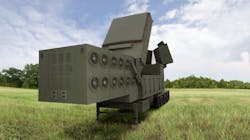Raytheon chooses Crane for power electronics control and conditioning for LTAMDS missile-defense radar
ANDOVER, Mass. – Radar systems designers at the Raytheon Co. needed power electronics for the company's Lower Tier Air and Missile Defense Sensor (LTAMDS) radar program. They found their solution from Crane Aerospace & Electronics in Lynnwood, Wash.
Officials of the Raytheon Integrated Defense Systems segment in Andover, Mass., have selected Crane to provide defense power systems for power control and conditioning for LTAMDS, the U.S. Army's next-generation missile-defense radar.
Raytheon reported last month that the Army chose the company to provide LTAMDS as the next generation, 360-degree capable radar that ultimately will replace the current U.S. Army's Patriot missile radars.
Raytheon won a contract worth more than $384 million to deliver six production representative units of LTAMDS, which will operate on the Army's Integrated Air and Missile Defense network. Crane A&E is supplying the power system for the LTAMDS.
Developed to defeat advanced threats, Raytheon’s LTAMDS design features cutting-edge radar technology including gallium nitride, company officials say. LTAMDS is scheduled to reach initial operational capability with the Army in 2022. In addition to Crane, LTAMDS uses a diverse team of suppliers across 35 states.
Raytheon, using Crane's defense power systems, competed in a two-week sense-off last May that put Raytheon's LTAMDS through challenging scenarios. The sense-off aimed to accelerate fielding the Army's Patriot radar modernization program.
Raytheon's winning LTAMDS solution is a 360-degree, active electronically scanned array (AESA) radar powered by Raytheon-manufactured gallium nitride (GaN), a substance that strengthens the radar signal and enhances its sensitivity.
Among Crane's military power electronics products are three-phase AC-DC power with active power correction for high-power systems operating from three-phase alternating current source.
These are for systems or applications where the load approaches the source capacity, which often must impose strict harmonic limits, even when not required by regulation, to enable the source to maintain sufficient voltage waveform quality for other systems to operate.
Crane provides active switching conversion for applications that require regulation, where source frequency is 50/60 Hz, or both. The company also provides passive power solutions where the source frequency is higher, such as 400 Hz, due to their simplicity and robustness.
Crane also provides traveling wave tube (TWT) power supplies in either AC-DC or DC-DC versions that are configured to operate from the prime power that is available from ships, planes, or other power distribution systems.
The company's TWT power products are custom developed to integrate with radar transmitters, electronic countermeasures, and satellite high power communications amplifiers driving TWTs.
For more information contact Raytheon Integrated Defense Systems online at www.raytheon.com, or Crane Aerospace & Electronics at www.craneae.com.

